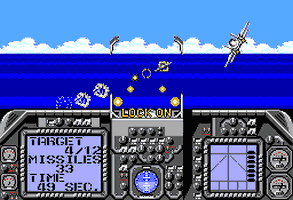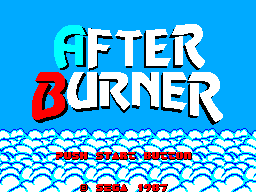Game: G-LOC
Console: Sega Master System
Developer: Sega
Release Date: 1991
The first thing the player is met with upon starting the game is a choice of normal or inverted controls, which is nice to see in flying games, as everyone has their favourite control type, and playing the reverse of it usually leads to poor performance. Once you've chosen your controls and difficulty setting from 3 grades of difficulty, you're greeted by a notebook, which serves as the menu for the game. Here you can find how many points you need to complete the game (each mission you complete earns you points), how many missiles and how much time you remaining as well as your aircraft's current damage level (this carries over each mission).
Turning the page in the notebook takes you to a choice of missions, with targets such as planes, bases, tanks and warships. There are a few different arenas of combat, sea, desert and plain; each essentially being recoloured versions of each other. There's also no real difference between fighting enemies in the desert and fighting them any where else. On the last set of pages you can buy upgrades; more time, more health and more missiles before beginning your selected mission.
Once the mission begins the player is given a cockpit view, and can begin to shoot down the required number of whichever enemy they have chosen. Graphically the game is quite impressive for the Master System, everything's pretty well defined and movement is smooth. Its easy to see what you have to aim for and the perspective of flying works well. The player is able to move around the screen but there are limits to how far up/left/down/right you can move, so there's no chance of crashing, at least.
Shooting down enemies can be done in one of two ways, there's an aircraft gun in addition to missiles, although the missiles are guided whereas the gun is not, so most of the time it's easier to wait for the target to be auto-locked and fire a missile. This can make the game feel less challenging, after all an integral part of the excitement from flying combat games is lining up an enemy in your sights, but only using the aircraft gun may prove a bit too challenging as it has limited range.
Upon completing the mission you're given some more time and missiles, in addition to the points promised at the beginning of the mission, towards your total. Occasionally on the notebook menu you're given the option of bonus missions and mini boss battles, which make a nice change from the regular missions. The controls are fairly good for the time, and the difficulty curve across the missions escalates nicely. In later missions, you'll get the chance to do some evasive maneuvering away from enemy fire.
The final boss is one fighter jet which you have to keep in your sights to avoid going into the defensive mode, where you'll have to avoid his attacks. Once this boss is defeated the game is complete and you're told to try a harder difficulty mode. Without a whole lot of variety to the gameplay, sometimes the point targets seem a little high, to complete the game, but as a master system game, its really not too bad at all.
Rating: 65/100
Grade: C
Game: After Burner
Console: Sega Master System
Developer: Sega (AM2)
Release Date: 1988
Afterburner is an arcade style combat flight simulator which is level based as opposed to mission based. The game is in a 3rd person view and relies much more heavily on the aircraft guns for shooting than missiles, although it has both. The targeting system works differently, on the missiles, not automatically locking on but requiring the player to keep an enemy in their sights for a little while.
The gameplay is ultimately more rewarding than that of G-LOC, targeting an enemy feels more natural and although there's less variety of enemies, there are bigger explosions when you do hit them, and more variance in the scenery behind the levels. I'm not entirely sure what the criteria is to advance from one level to the next, it seems as if its "after a random amount of time", but there is progression at least.
The music in Afterburner is suited to the combat and arcade style with good sound effects also for the most part. Visually its almost hard to pick a winner between this and G-LOC, but I'd personally go with Afterburner as it was released 3 years before and almost looks better. Without set gameplay goals, this is undoubtedly more of a sky based arcade shoot 'em up. What it lacks in immersion it makes up for in having a more carefree, fun approach to the genre.
The controls feel tight and responsive, the flying is similar to G-LOC in that you can only go so far eitherway on screen, and you'll never crash. Dodging missiles fired by enemy planes is the only defensive element of the game, but it works well with the arcade style in that it doesn't disrupt the game's flow.
There are 18 levels in Afterburner, making it a significantly longer game than G-LOC, however it is also more difficult to get to the later levels, since the player only has 3 lives with which to advance. Even using a code to pick up where I left off after dying, I was only able to make it to level 6, however the levels up to that point had been fairly repetitive with "Shoot everything in the sky" being the main goal.
Overall Afterburner is like a flying version of Space Harrier (unsurprising as both were developed by Yu Suzuki), which plays nicely and has some good concepts. Perhaps a little added kill counter or "x until next level" would be nice on the HUD, but overall this satisfies as a sky-based arcade shoot em up.
Rating 66/100
Grade: C
Between the two games, its a very close call. The strategic, mission based approach of G-LOC, and the fun, tightly controlled arcade action of Afterburner are two decent approaches to the Combat Flight Shoot'em Up genre. Afterburner seems to be slightly more rewarding to play, and to have stood the test of time a little better than G-LOC, but they're both well worth a try. Based on its catchier music and better visuals, as well as tight controls and satisfying arcade gameplay, Afterburner wins this round.







No comments:
Post a Comment